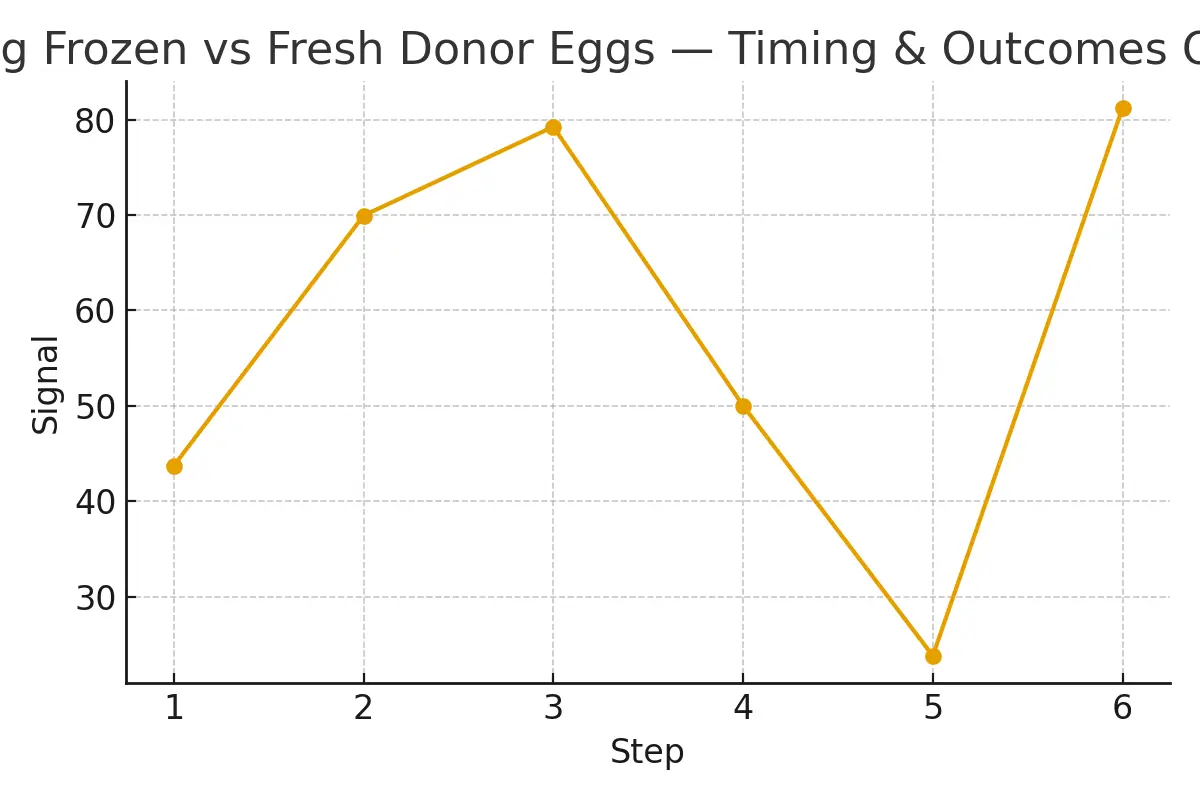
Choosing between frozen and fresh donor eggs is one of the most impactful decisions in the LGBTQ+ family-building journey. This choice affects costs, success rates, and timelines—ultimately shaping your path to parenthood.
What It Is
Using frozen donor eggs means selecting eggs already retrieved and preserved from a donor.
Using fresh donor eggs means syncing your cycle with a donor’s stimulation and retrieval process.
Both options can lead to healthy pregnancies, but they differ in timing, logistics, and how outcomes are optimized.
Who It Helps
This decision is especially relevant for:
- LGBTQ+ intended parents choosing egg donors
- Families balancing speed vs success probability
- Parents navigating budget constraints or lab access
- Individuals whose medical history, age, or fertility markers suggest higher embryo numbers may be important
If donor eggs are not part of your pathway (e.g., self-carry with own eggs), this choice may not apply.
Step-by-Step
A structured sequence helps reduce stress and protect embryo quality:
- Define your priorities – cost, speed, embryo numbers, genetic testing
- Review lab quality indicators – success depends heavily on clinic performance
- Screen donor options – medical history, genetic testing, proven fertility
- Decide fresh vs frozen – based on priorities and clinic recommendations
- Align protocols – synchronize calendars, pharmacy orders, and legal steps
Pros & Cons
Frozen Donor Eggs
- Faster start (no need to wait for donor cycle)
- Lower upfront cost
- Predictable number of eggs available
- Typically fewer eggs retrieved → fewer embryos
- Slightly lower success rates compared to fresh
Fresh Donor Eggs
- Higher egg yield → more embryos to work with
- Better cumulative success rates
- Flexibility in fertilization and genetic testing
- Longer process (must sync with donor’s cycle)
- Higher cost
- More complex scheduling/logistics
Costs & Logistics
- Frozen: package pricing, smaller egg lots, lower total cost but limited embryos
- Fresh: higher clinic fees, stimulation medications, legal coordination, but more embryos per cycle
- Cash Flow: escrow accounts + pharmacy fulfillment planning prevent surprise bills
- Insurance: check coverage for retrieval meds, labs, and carrier cycle prep
What Improves Outcomes
- Lab quality indicators → strongest predictor of live birth
- Donor screening standards → reduces risk of cycle failure
- Protocol timing & clinic calendar alignment → prevents wasted cycles
- Genetic testing decisions → improves implantation odds
- Mental health & support → reduces stress, improves communication
- Budget & escrow planning → stabilizes cash flow and prevents mid-cycle delays
Case Study
One couple wanted the fastest path to pregnancy and chose frozen donor eggs. They received six eggs, which resulted in two good-quality embryos. The first transfer failed, but the second succeeded, leading to a healthy birth.
Another couple chose fresh donor eggs, yielding 20 eggs and 6 embryos after testing. This gave them not only their first child but also embryos stored for future siblings.
Lesson: Frozen works best for speed and lower budgets; fresh offers higher cumulative family-building potential.
Mistakes to Avoid
- Choosing only on price without considering embryo needs
- Skipping donor genetic screening
- Overlooking lab performance metrics
- Failing to align clinic/pharmacy timelines
- Not setting up escrow for predictable payments
FAQs
Q. Are frozen donor eggs less successful than fresh?
Ans : Yes, success rates are usually slightly lower with frozen eggs, but many families achieve live births with either option. Lab quality matters more than the egg source itself.
Q. How many eggs come in a frozen donor egg lot?
Ans : Typically 6–8 eggs. This usually produces 1–2 good embryos, compared to fresh cycles where multiple embryos are often created.
Q. Which option is faster?
Ans : Frozen donor eggs are immediately available, so the process moves faster. Fresh requires coordinating with a donor’s cycle, which adds weeks to months.
Q. Is fresh always better for long-term family building?
Ans : Yes, if you want multiple children from the same donor, fresh cycles usually give more embryos, making sibling planning easier.
Q. How should we decide between frozen and fresh?
Ans : Base your decision on your priorities:
- Speed & lower cost → Frozen
- Higher embryo numbers & cumulative success → Fresh

Dr. Kulsoom Baloch
Dr. Kulsoom Baloch is a dedicated donor coordinator at Egg Donors, leveraging her extensive background in medicine and public health. She holds an MBBS from Ziauddin University, Pakistan, and an MPH from Hofstra University, New York. With three years of clinical experience at prominent hospitals in Karachi, Pakistan, Dr. Baloch has honed her skills in patient care and medical research.




